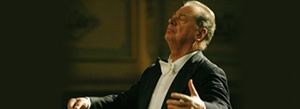The crowd who came to see the renowned 80-year-old Spanish conductor Rafael Frühbeck de Burgos conduct the LA Phil on Saturday night at Disney Hall seemed much younger and more diverse than usual. It didn’t become clear why until Maestro Frühbeck de Burgos walked on stage and then again at the conclusion of each piece on the program. This audience was there mainly to see him. It also became clear why after watching him conduct the three pieces on the program: Haydn’s Symphony No. 1 and Symphony No. 100, the “Military,” so called because of the march-like rhythm and the unusual percussion (triangle, cymbals and bass drum) in the second — “Militaire” — movement, and Rimsky-Korsakov’s Scheherazade.
The first half of the program consisted of the two Haydn symphonies which, even though separated by about 36 years (interestingly, more than the lifespan of Mozart and Schubert), are immediately recognizable as Haydn. Both are lively, spirited and cheerful, and have the same kind of playful quality that one finds in much of his work.
And unlike Mozart, for example, who had written 34 symphonies by the time he was about 24 years old (having written his first one when he was 8!), Haydn was 25 years old when he penned his Symphony No. 1. In contrast to Mozart’s early symphonies which, though portending his brilliance to come, are clearly immature works, Haydn’s First Symphony sounds like the work of a mature composer.
Frühbeck de Burgos seemed frail as he walked slowly onstage and then carefully stepped on the podium. But any signs of frailty quickly dissipated when he began conducting the Haydn First Symphony which almost acted as an elixir for the ravages of old age. Frühbeck de Burgos became animated, moving as if he were much younger. Because the Haydn Symphony No. 1 is scored largely for strings (the two oboes and two horns are there mostly for accents and background for the strings), it gave the strings of the LA Phil a chance to really shine. And under the baton of a master (and a violinist himself) they really played as if they were one organism, moving in complete unison. It was a very enjoyable performance.
The Symphony No. 100 is Haydn at his most mature as a symphonist and, in addition to the added percussion in the second and fourth movements, the melodies are memorable, and it has the same buoyancy that can be heard in the First Symphony and indeed in much of his work. The larger, more modern orchestra also added contrast to the First Symphony. Once again, Frühbeck de Burgos seemed rejuvenated as he expertly took the orchestra through its steps.
But, as delightful as the first half was, it was only the appetizer for the main course, the symphonic suite Scheherazade by Rimsky-Korsakov. Scheherazade consists of four separate movements, each corresponding to a tale told to the Sultan by Sheherazade for 1,001 nights to postpone her execution. The titles are “The Sea and Sinbad’s Ship,” “The Kalendar Prince,” “The Young Prince and the Young Princess,” and “Festival at Baghdad; The Sea; The Ship Breaks Against a Cliff Surmounted by a Bronze Horseman.” Rimsky-Korsakov represents Scheherazade with the solo violin, initially introduced and then reappearing accompanied only by a solo harp.
LA Phil Concertmaster Martin Chalifour played the solo part with passion, but it didn’t quite succeed in evoking the feminine sensitivity that one would associate with Scheherazade. A shout out also goes to Principal Cellist Robert deMain. In fact, Scheherazade is a showcase not only for the large orchestra, but also for many of the principals. For example, especially in the third movement, there are extended solos for bassoon, flute, oboe, clarinet and horn, and the LA Phil’s principals (Whitney Crockett, Julien Beaudiment, Ariana Ghez, Michele Zukovsky and Brian Drake, respectively) showed why the woodwind section is really second to none.
Frühbeck de Burgos took the audience on an enchanted ride through Rimsky-Korsakov’s evocative composition, leading them over rough seas and shipwrecks, through festivals and the intimate relationship between Scheherazade and the Sultan. At the conclusion, it was clear why so many came out to see this renowned conductor work his musical magic.
—Henry Schlinger, Culture Spot LA
For information about upcoming concerts, visit www.laphil.com.






